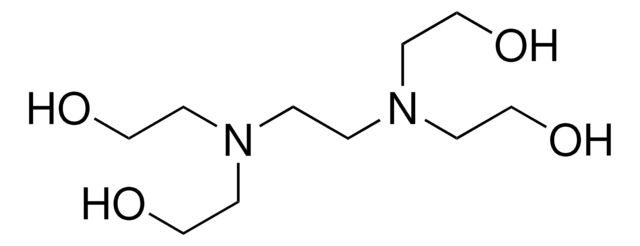122262
N,N,N′,N′-Tetrakis(2-Hydroxypropyl)ethylenediamine
98%
Synonym(s):
Edetol, Entprol, (Ethylenedinitrilo)tetra-2-propanol, Quadrol®
About This Item
Recommended Products
vapor pressure
1 mmHg ( 20 °C)
Assay
98%
refractive index
n20/D 1.4812 (lit.)
bp
175-181 °C/0.8 mmHg (lit.)
density
1.013 g/mL at 25 °C (lit.)
SMILES string
CC(O)CN(CCN(CC(C)O)CC(C)O)CC(C)O
InChI
1S/C14H32N2O4/c1-11(17)7-15(8-12(2)18)5-6-16(9-13(3)19)10-14(4)20/h11-14,17-20H,5-10H2,1-4H3
InChI key
NSOXQYCFHDMMGV-UHFFFAOYSA-N
General description
Application
- A monomer in the synthesis of covalently cross-linked and amorphous shape memory polyurethane (SMPU) foams that are used in biomedical applications, which includes SMPU actuators for treating ischemic stroke, thrombus removal activated by laser light, self-deployable SMP neuronal electrodes, vascular stents, sutures in microsurgery, ocular implants, bandages, cell manipulation, and cell therapy.
- A precursor in the preparation of self-healing CFRPs (carbon fiber reinforced polymer) which are thermally responsive with excellent mechanical properties.
- A crosslinking agent to create a hydrogel that is biocompatible and supports the growth of neural cells. Hydrogels are specifically designed to mimic the properties of the extracellular matrix (ECM), in promoting cell proliferation. The purpose of the hydrogel in this context is to act as an extracellular matrix (ECM) substitute, providing a supportive environment for cell growth and guiding cell adhesion and outgrowth. This study investigates the potential of the peptide-modified channels to facilitate neural tissue engineering and enhance cell proliferation within the hydrogel-based scaffold.
Legal Information
Signal Word
Warning
Hazard Statements
Precautionary Statements
Hazard Classifications
Eye Irrit. 2
Storage Class Code
10 - Combustible liquids
WGK
WGK 1
Flash Point(F)
411.8 °F - closed cup
Flash Point(C)
211 °C - closed cup
Personal Protective Equipment
Certificates of Analysis (COA)
Search for Certificates of Analysis (COA) by entering the products Lot/Batch Number. Lot and Batch Numbers can be found on a product’s label following the words ‘Lot’ or ‘Batch’.
Already Own This Product?
Find documentation for the products that you have recently purchased in the Document Library.
Our team of scientists has experience in all areas of research including Life Science, Material Science, Chemical Synthesis, Chromatography, Analytical and many others.
Contact Technical Service





